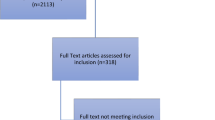Abstract
Introduction/Aims
Implicit bias can impact physician–patient interactions, alter treatment recommendations, and perpetuate health disparities. Medical educators need methods for raising student awareness about the impact of bias on medical care.
Setting
Seventy-two third-year medical student volunteers participated in facilitated small group discussions about bias.
Program Description
We tested an educational intervention to promote group-based reflection among medical students about implicit bias.
Program Evaluation
We assessed how the reflective discussion influenced students’ identification of strategies for identifying and managing their potential biases regarding patients. 67% of the students (n = 48) identified alternate strategies at post-session. A chi-square analysis demonstrated that the distribution of these strategies changed significantly from pre-session to post-session \( \left( {{X^2}\left( {11} \right) = 27.93,\,p < 0.01} \right) \), including reductions in the use of internal feedback and humanism and corresponding increases in the use of reflection, debriefing and other strategies.
Discussion
Group-based reflection sessions, with a provocative trigger to foster engagement, may be effective educational tools for fostering shifts in student reflection about bias in encounters and willingness to discuss potential biases with colleagues, with implications for reducing health disparities.
Similar content being viewed by others
References
Balsa AI, McGuire TG. Prejudice, clinical uncertainty and stereotyping as sources of health disparities. J Health Econ. 2003;22(1):89–116.
van Ryn M, Fu SS. Paved with good intentions: do public health and human service providers contribute to racial/ethnic disparities in health? Am J Public Health. 2003;93(2):248–55.
van Ryn M. Research on the provider contribution to race/ethnicity disparities in medical care. Med Care. 2002;40(1 Suppl):I140–I151.
Green AR, Carney DR, Pallin DJ, et al. Implicit bias among physicians and its prediction of thrombolysis decisions for black and white patients. J Gen Intern Med. 2007;22(9):1231–8.
Burgess D, van Ryn M, Dovidio J, Saha S. Reducing racial bias among health care providers: lessons from social-cognitive psychology. J Gen Intern Med. 2007;22(6):882–7.
Wegener DT, Dunn M, Tokusato D. The flexible correction model: phenomenology and the use of naive theories in avoiding or removing bias. In: Moskowitz GB, ed. Cognitive Social Psychology: The Princeton Symposium on the Legacy and Future of Social Cognition. Mahwah: Lawrence Erlbaum; 2001:277–90.
Mann KV. Reflection: understanding its influence on practice. Med Educ. 2008;42(5):449–51.
Murray-Garcia JL, Harrell S, Garcia JA, Gizzi E, Simms-Mackey P. Self-reflection in multicultural training: Be careful what you ask for. Acad Med. 2005;80(7):694–701.
Thompson BM, Teal CR, Rogers JC, Paterniti DA, Haidet P. Ideals, Activities, Dissonance, and Processing: A Conceptual Model to Guide Educators’ Efforts to Stimulate Student Reflection. Academic Medicine. In press.
Greenwald AG, McGhee DE, Schwartz JL. Measuring individual differences in implicit cognition: the implicit association test. J Pers Soc Psychol. 1998;74(6):1464–80.
Gawronski B. What does the implicit association test measure? A test of the convergent and discriminant validity of prejudice-related IATs. Exp Psychol. 2002;49(3):171–80.
Ring J, Nyquist J, Mitchell S, Flores H, Samaniego L. Curriculum for Culturally Responsive Health Care: The Step-by-Step Guide for Cultural Competence Training. Oxford: Radcliffe Publishing; 2008.
Project Implicit. https://implicit harvard edu/implicit/demo/ 2009. Accessed June 30, 2009.
Burgess DJ, Fu SS, van Ryn M. Why do providers contribute to disparities and what can be done about it? J Gen Intern Med. 2004;19(11):1154–9.
Teal C, Gill A, Shada RE et al. The Implicit Association Test: A Good Trigger for Reflective Discussion about Biases and Healthcare Disparities? under editorial review 2010.
Gill A, Thompson B, Teal C, Shada R, Fruge E, Villarreal G, et al. Best Intentions: Using the Implicit Associations Test to Promote Reflection About Personal Bias. MedEdPORTAL; 2010. Available from: http://services.aamc.org/30/mededportal/servlet/s/segment/mededportal/?subid=7792
Davis DA, Mazmanian PE, Fordis M, Van HR, Thorpe KE, Perrier L. Accuracy of physician self-assessment compared with observed measures of competence: a systematic review. JAMA. 2006;296(9):1094–102.
Hodges B, Regehr G, Martin D. Difficulties in recognizing one's own incompetence: novice physicians who are unskilled and unaware of it. Acad Med. 2001;76(10 Suppl):S87–S89.
Kumagai AK, Lypson ML. Beyond cultural competence: critical consciousness, social justice, and multicultural education. Acad Med. 2009;84(6):782–7.
Beach MC, Rosner M, Cooper LA, Duggan PS, Shatzer J. Can patient-centered attitudes reduce racial and ethnic disparities in care? Acad Med. 2007;82(2):193–8.
Weiner SJ, Barnet B, Cheng TL, Daaleman TP. Processes for effective communication in primary care. Ann Intern Med. 2005;142(8):709–14.
Acknowledgements
This work was supported in part by the Houston VA HSR&D Center of Excellence (HFP90-020, from the Office of Research and Development, U.S. Department of Veterans Affairs. This work was also supported by K07-HL85622 from the National Heart, Lung, and Blood Institute, and K07 HL082629-01 from the National Institutes of Health Office of Behavioral and Social Sciences Research. The funders had no role in writing or the decision to submit this report for publication. The views expressed in this article are those of the authors and do not necessarily represent the views of the Department of Veterans Affairs.
Conflict of Interest
The authors report no conflicts of interest. Dr. Haidet has been a consultant for Merck Inc. during the last 3 years.
Author information
Authors and Affiliations
Corresponding author
Rights and permissions
About this article
Cite this article
Teal, C.R., Shada, R.E., Gill, A.C. et al. When Best Intentions Aren’t Enough: Helping Medical Students Develop Strategies for Managing Bias about Patients. J GEN INTERN MED 25 (Suppl 2), 115–118 (2010). https://doi.org/10.1007/s11606-009-1243-y
Published:
Issue Date:
DOI: https://doi.org/10.1007/s11606-009-1243-y




